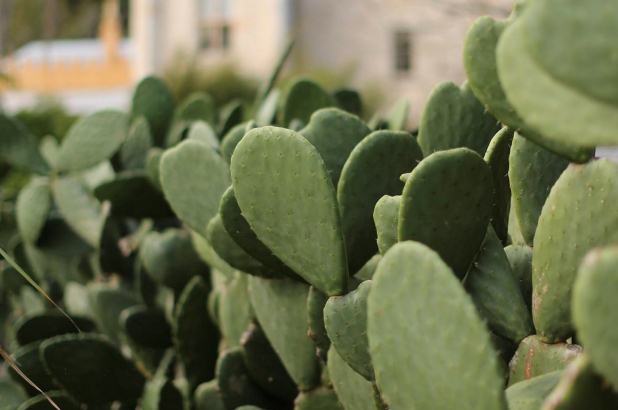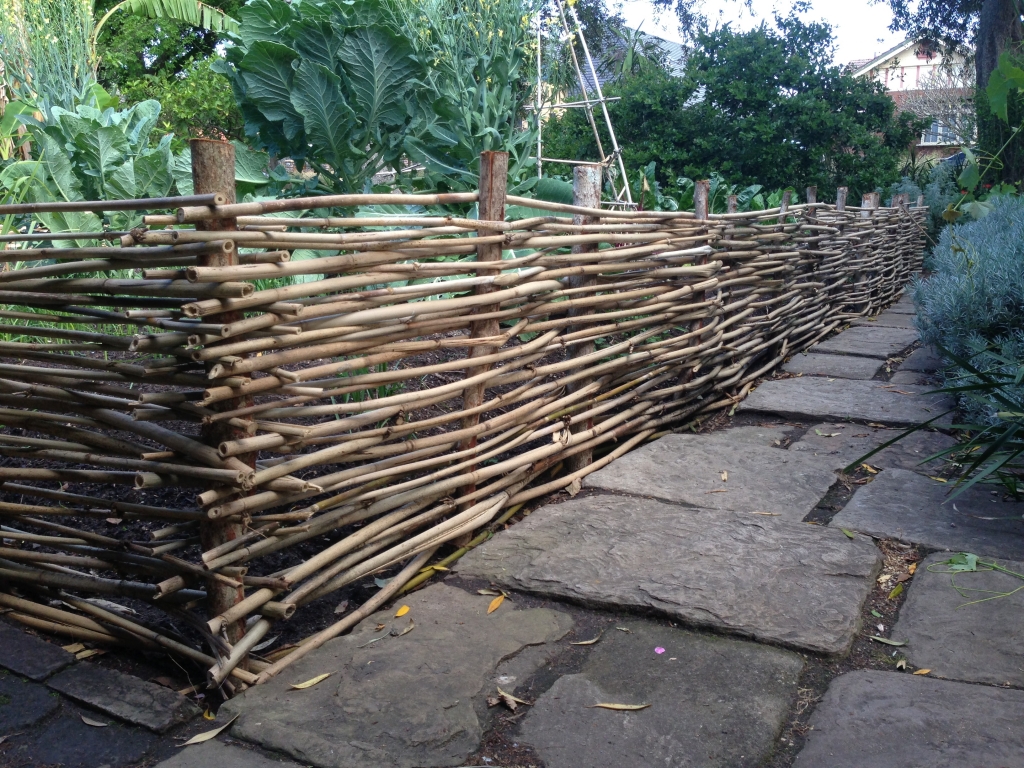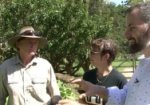Long before chicken wire, the early colonists had some fearsome options when it came to protecting their salad greens!
Kitchen garden fences basically serve to protect vegetables and fruit from the weather (by creating a micro-climate) or to protect the contents from being pilfered by animals or people. While keeping stray animals from feasting – and fences to keep out rabbits would all too soon become essential – early colonial gardens were fenced primarily to stop the theft of valuable produce as much as define ownership. Given food scarcities and the chronic shortage of hard currency for many years, anything that could be bartered was valuable: food was money. It was the first time in the continent’s long history that physical fences divided the landscape.
Garden Island, now a navy base, was named for the kitchen garden established there by the crew of the Sirius: in its case the harbour itself was the fence, just as the ocean and the unknown bush were considered the ‘walls’ of the new penal colony. Few colonists could swim with any competency, and rowboats were closely controlled. It wasn’t always a successful barrier, as Lt. Ralph Clark discovered to his great annoyance:
Thursday 18 [February 1790] Cloudy Weather — after I was Releved from Guard I went down to my Island to look at my Garden and found that Some Boat had landed Since I had been there last and taken away the Greatest part of a fine Bed of Onions — it is impossible for any body to attemp to raise any Gardin Stuff for before it comes to perfection the[y] will Steal it — I thought that having a Garden on an island it would be more Secure but I find that they even get at it
His was a habitual thief, as only 3 days later he recorded (with his idiosyncratic spelling):
Sunday 21 [February 1790] Fine weather — Soon after breackfast I went out in my Boat down to my Island to See my Garden and found that Some persons had been ther again and have taken away all my potatoes — however the[y] are I wish that the[y] were in hell for ther kindness. [1]
The island in question now bears his name, and is the focus of the views from Elizabeth Bay House.
“Meanwhile, at the Elizabeth Bay…”
Sketch of Elizabeth Bay, Sydney N. S. Wales Sept 3 1827. T. Wright Hughes, Buffs [3rd East] Kent Reg[iment], 1827. Camden Park Preservation Committee
This detail shows it with a new, tightly spaced paling fence, probably made from locally felled timber. The palings are all around head-height, with pointed tops and supported by a single rail behind – not easy to get into! Labourers can be seen working on a gridded garden layout with 1 central and 2 lateral paths. There is the faintest suggestion of individual beds. This same grid layout is seen in other contemporary gardens, such as William Macarthur’s first garden at Camden Park, and Captain Piper’s Henrietta Villa located two headlands east of Elizabeth Bay. In this view you can see the latter’s cruciform shaped garden also surrounded by a paling fence and with an internal grid of beds:
At Elizabeth Farm today our garden team recently installed another form of traditional fence: a low ‘hurdle’ of woven – or ‘wattled’ – bamboo cut from the ornamental stand in the eastern garden. Hurdles in Europe were traditionally made from pliable, easily woven willow. Just over a foot high, this hurdle fence was installed to keep out the local menace – rabbits! Even in suburban Rose Hill the never ending battle between ‘Mr Macgregor and Peter Rabbit’ over the salad greens is played out.
Aside from tried and tested wooden palings, there were other, particularly nasty options to choose from…
“Recommended to the attention of the settlers of New South Wales…”
Today at Vaucluse House’s kitchen garden you can see two particularly nasty options for fencing a colonial kitchen garden – prickly pear and bush lemons.
In the early 1830s, just as John Macarthur had before him, colonist James Busby traveled to France and then on to Spain. He was studying olives groves and vineyards, and evaluating their methods of wine production so as to improve NSW viticulture. In 1835 he published his account [2], and John Claudius Loudon reviewed the publication in his ‘Gardener’s Magazine’ [3]. Busby also wrote of the fearsome hedges he saw in Andalucia, Spain:
Monday, 3d October.—Mr. James Gordon having invited Dr. Wilson and myself to visit a vineyard belonging to him about four miles from Xeres [now Jeres], we accordingly started about one o’clock… The road lay between immense hedges of the cactus or prickly pear, and aloe, planted on the top of high banks, and making a fence which would prove a considerable impediment to the march of an army.
OUCH! A brave army indeed – though no horse, cow or goat in its right mind would also try and push through. He continued:
Mr. Gordon pointed out a hedge of prickly pears, two years old; and which, even though it had been on the level ground, would already prove a very tolerable fence. He is of opinion that the original plants, if properly looked after, will form a fence for forty years; and if renewed with occasional fresh plants, would last for ever. The aloe is also much used for fencing, but is considered by Mr. Gordon as very inferior to the prickly pear, as it dies off whenever it has flowered. There is a prejudice that this plant flowers only once in a hundred years, and it is thence called the centennial aloe. The truth is, that though it is often many years in flowering, when it has once flowered it dies off for ever.
The second plant he describes is not actually an aloe (which were of South African origin) but likely the far fiercer Agave americana (from Central America) with its spiked leaf edge and vicious spines. Busby thought he was on to a winner:
If there is any part of the rural economy of the Andalusians which the settler of New South Wales could adopt with advantage, it is the hedge of prickly pears. It is not possible to imagine a more effectual fence, nor one which it would take less trouble to plant or keep in order. It is only necessary to place, at certain distances along the proposed line, a leaf or part of a leaf of the plant. In nineteen cases out of twenty they will take root without any further trouble; and in two years, or three at the farthest, there will be a more effectual fence than a four-railed one. The only objection to this kind of fence is the room it occupies after a few years growth, if not pruned down; but, in New South Wales, we are not yet so much pressed for room as to make this an objection. To those who may feel inclined to adopt this recommendation it may be a useful hint. Though I was told it was scarcely possible to keep the prickly pears from growing, even by cutting the leaves into small pieces and throwing them on a dry spot, still it would be worth the trouble to place each leaf, or part of a leaf, in a spadeful of manure, both to insure its striking and its more vigorous growth.
Prickly pear fences were quite likely already in use however. In February 1826 “a correspondent” wrote to the Gazette exhorting the colonists to experiment with cotton, wheat and olive oil. “Nor” he continued, “should the Society fail to promote the culture of the Indian fig (Cactus), as being well calculated to furnish you with good hedges” [4]. If you look at the drawing of Elizabeth Bay’s kitchen garden (above) you can also see two conspicuous plants just to its right: irregular and with very large paddle-like ‘leaves’ (called ‘nopales’ in Mexico) these are almost certainly prickly pears, and are perhaps an earlier attempt at establishing a hedge.

Young ‘paddles’ on the prickly pear hedge at Vaucluse House. Photo Scott Hill © Sydney Living Museums
Prickly pear and agave hedges were surely seen by the British in southern Italy and Sicily during the 1st Napoleonic War. In 1828 Joseph Woods published his ‘Letters of an architect in France, Italy and Greece” (London, John & Arthur Arch, Vol.1 p354). It was referenced by Loudon: “Hedges in Sicily are frequently formed by Agave Americana which Wood informs us make an excellent fence for one or two years before flowering; yet as the old plants die immediately afterwards, two or three years elapse before the offsets are sufficiently advanced to supply its place effectually. The cactus is also employed as a fence but after sometime the lower parts of the state lose their prickles and men and animals may creep through.” [5] The agave, it seems, was planted as an understory to fill in the gaps.
Busby’s notes as to the prolififc nature of the prickly pear are in retrospect a glaring warning. Prickly pears (in this case Opuntia monocantha, the ‘smooth prickly pear’) were introduced with the First Fleet not for fencing or their edible fruit, but because they were a host for the cochineal insect. When squashed (yuck!) it secreted a strong red dye – the source of the British ‘red coats’. The plants were moved inland as both decorative pot plants and (as Busby advocated) impenetrable hedges. The species thrived. By the time the cactoblastis cactorum moth was introduced to combat it, over 58 millions hectares of the plant (mostly the Common Pest Pear O.and Tiger Pear) infested NSW and Queensland alone [6]. Ironically the first method of control, simple digging up and discarding the plants, spread the plant even faster. Prickly pears grown today at Vaucluse House and Elizabeth Farm are not these species but opuntia ficus-indica, the ‘Indian fig’, from which the fruit is gathered.
The second fierce hedging at Vaucluse is of bush lemon (Citrus x taitensis), grown not for its fruit but its dense habit and long spines. You can see it here growing on the east side of the kitchen garden, while a full sized, untrimmed version grows at Elizabeth Farm:
References
[1] Ralph Clark (d.1794), The Journal and Letters of Lt. Ralph Clark 1787-1792. From the print edition published by Australian Documents Library in Association with The Library of Australian History Pty Ltd Sydney 1981. Edited by Paul G. Fidlon and R. J. Ryan
[2] James Busby, Journal of a recent Visit to the principal Vineyards of Spain and France; with some Remarks on the very limited Quantity of the finest Wines produced throughout the World, and their consequent intrinsic Value; an Attempt to calculate the Profits of cultivating the Vine ; a Catalogue of the different Varieties of Grape ; and an Estimate of the Profits of Malaga Fruits; together with Observations relative to the Introduction of the Vine into New South Wales. By James Busby, Esq. London, 1834.
You can read the 1838 edition online here.
[3] John Claudius Loudon, The Gardener’s Magazine, and Register of Rural and Domestic Improvement, London; Longman Rees Orme Brown Green & Longman. 1835, Vol 11, p92
[4] The Sydney Gazette, Saturday 4 February, 1826
[5] J.C. Loudon, An Encyclopædia of Gardening. London; Longman, Rees, Orme, Brown, Green & Longman. 1835
[6] The Prickly Pear pest in New South Wales; authorized by the Minister for Lands. The Prickly Pear Destruction Commissioner, Sydney, 1967.
Read more about the islands of Sydney Harbour at the Dictionary of Sydney.






